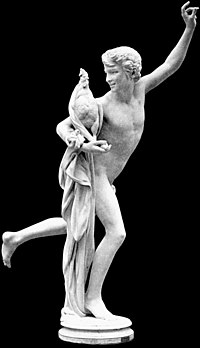
Jean Alexandre Joseph Falguière (French pronunciation: [ʒɑ̃ alɛksɑ̃dʁ ʒozɛf falɡjɛʁ]; also given as Jean-Joseph-Alexandre Falguière, or in short Alexandre Falguière) (7 September 1831 – 20 April 1900) was a French sculptor and painter.
Biography

Falguière was born in Toulouse. A pupil of the École des Beaux-Arts, he won the Prix de Rome in 1859; he was awarded the medal of honor at the Paris Salon in 1868 and was appointed Officer of the Legion of Honor in 1878.
Falguière's first bronze statue of importance was Le Vainqueur au Combat de Coqs (Victor of the Cockfight) (1864), and Tarcisius the Christian Boy-Martyr followed in 1867; both were exhibited in the Luxembourg Museum and are now in the Musée d'Orsay. His more important monuments are those to Admiral Courbet (1890) at Abbeville and the famous Joan of Arc. Other works include Eve (1880), Diana (1882 and 1891), Woman and Peacock (a. k. a. Juno and The Peacock), and The Poet, astride his Pegasus spreading wings for flight. He sculpted The Dancer, based on Cléo de Mérode which today is also in the Musée d'Orsay. In 1870 he helped create the snow sculpture, La statue de la Résistance.
To these works should be added his monuments to Cardinal Lavigerie and to Marquis de Lafayette (in Washington, DC), and his statues of Alphonse de Lamartine (1876) and St Vincent de Paul (1879), as well as the Honoré de Balzac, which he executed for the Société des gens de lettres on their rejection of that by Auguste Rodin; and the busts of Carolus-Duran and Ernest Alexandre Honoré Coquelin (1896).
Falguière was a painter as well as a sculptor. His Wrestlers (1875) and Fan and Dagger (1882; a defiant Spanish woman) were in the Luxembourg, and other pictures of importance are The Beheading of St John the Baptist (1877), The Sphinx (1883), Acis and Galatea (1885), Old Woman and Child (1886) and In the Bull Slaughter-House.
Falguière also taught; among his students were Francis Edwin Elwell, Ernest Henri Dubois, Julien Caussé, Laurent Marqueste, Henri Crenier and Théophile Barrau.
Falguière became a member of the Institut de France (Académie des Beaux-Arts) in 1882.
Falguière died in Paris in 1900 and was interred there in the Père Lachaise Cemetery, where his monument is by his pupil Marqueste.
See also
- Léonce Bénédite (biographer)
- List of works by Alexandre Falguière
Notes
- ^
 One or more of the preceding sentences incorporates text from a publication now in the public domain: Chisholm, Hugh, ed. (1911). "Falguière, Jean Alexandre Joseph". Encyclopædia Britannica. Vol. 10 (11th ed.). Cambridge University Press. p. 147.
One or more of the preceding sentences incorporates text from a publication now in the public domain: Chisholm, Hugh, ed. (1911). "Falguière, Jean Alexandre Joseph". Encyclopædia Britannica. Vol. 10 (11th ed.). Cambridge University Press. p. 147.
- "Vainqueur au combat de coqs". Archived from the original on 25 October 2006. Retrieved 28 November 2006.
- Eckstein, Bob (2007). "The Revolution of 1870: The Snowman's French Roll". The History of the Snowman. Gallery Books. ISBN 978-1-4169-4066-1.
External links
 Media related to Alexandre Falguière at Wikimedia Commons
Media related to Alexandre Falguière at Wikimedia Commons- Works by or about Alexandre Falguière at the Internet Archive
- (in French) Insecula: index to pages displaying Falguière's work (it may be necessary to close an advertising window to view this page)
- Alexandre Falguière in American public collections, on the French Sculpture Census website

Categories:
- 1831 births
- 1900 deaths
- Artists from Toulouse
- Academic art
- Burials at Père Lachaise Cemetery
- 19th-century French painters
- French male painters
- Prix de Rome for sculpture
- École des Beaux-Arts alumni
- Members of the Académie des beaux-arts
- Officers of the Legion of Honour
- 19th-century French sculptors
- French male sculptors
- 19th-century French male artists